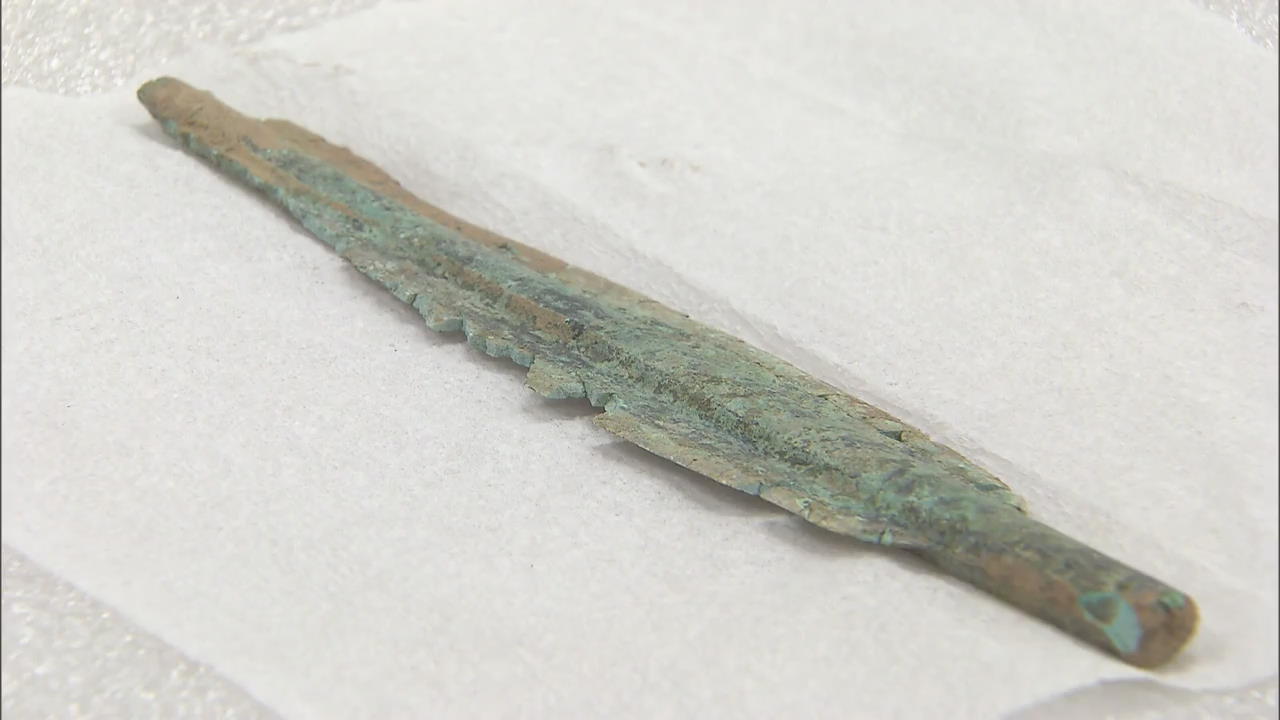Historic Dagger Find
입력 2016.08.03 (14:08)
수정 2016.08.03 (14:27)
읽어주기 기능은 크롬기반의
브라우저에서만 사용하실 수 있습니다.
[Anchor Lead]
A mandolin-shaped bronze dagger has been discovered at a Bronze Age residential site excavated in Cheongju, Chungcheongbuk-do Province, raising keen interest among scholars. Let’s take a look.
[Pkg]
This mandolin-shaped bronze dagger has a round inflated lower part. The relic is believed to be from the early half of the Bronze Age in the 9th century BC. The dagger was discovered in the Hakpyeongni township in Cheongju city along with other relics including an earthen pot with a double mouth rim. It's highly unusual to find a mandolin-shaped bronze dagger, believed to be a burial item for the tribal chief, at the site of a housing project.
[Soundbite] Lee Gyeong-sik(Korea Cultural Heritage Foundation) : "Mandolin-shaped bronze daggers were typically found from tombs, not residential sites, of the Bronze Age."
The first of its kind was excavated in 2014 in Chuncheon. The latest discovery is the second of the particular dagger.
[Soundbite] Prof. Kim Beom-cheol(Chungbuk Nat'l University) : "The latest find shows that mandolin-shaped bronze daggers were made not only as a burial good but also to be used in everyday life to boast the user's power and authority."
As the mandolin-shaped bronze dagger is the first to be found in the Chungcheongbuk-do Province area, scholars anticipate the find can trigger studies on ancient history such as Korea's relations with the Gojoseon kingdom.
A mandolin-shaped bronze dagger has been discovered at a Bronze Age residential site excavated in Cheongju, Chungcheongbuk-do Province, raising keen interest among scholars. Let’s take a look.
[Pkg]
This mandolin-shaped bronze dagger has a round inflated lower part. The relic is believed to be from the early half of the Bronze Age in the 9th century BC. The dagger was discovered in the Hakpyeongni township in Cheongju city along with other relics including an earthen pot with a double mouth rim. It's highly unusual to find a mandolin-shaped bronze dagger, believed to be a burial item for the tribal chief, at the site of a housing project.
[Soundbite] Lee Gyeong-sik(Korea Cultural Heritage Foundation) : "Mandolin-shaped bronze daggers were typically found from tombs, not residential sites, of the Bronze Age."
The first of its kind was excavated in 2014 in Chuncheon. The latest discovery is the second of the particular dagger.
[Soundbite] Prof. Kim Beom-cheol(Chungbuk Nat'l University) : "The latest find shows that mandolin-shaped bronze daggers were made not only as a burial good but also to be used in everyday life to boast the user's power and authority."
As the mandolin-shaped bronze dagger is the first to be found in the Chungcheongbuk-do Province area, scholars anticipate the find can trigger studies on ancient history such as Korea's relations with the Gojoseon kingdom.
■ 제보하기
▷ 카카오톡 : 'KBS제보' 검색, 채널 추가
▷ 전화 : 02-781-1234, 4444
▷ 이메일 : kbs1234@kbs.co.kr
▷ 유튜브, 네이버, 카카오에서도 KBS뉴스를 구독해주세요!
- Historic Dagger Find
-
- 입력 2016-08-03 14:09:24
- 수정2016-08-03 14:27:22

[Anchor Lead]
A mandolin-shaped bronze dagger has been discovered at a Bronze Age residential site excavated in Cheongju, Chungcheongbuk-do Province, raising keen interest among scholars. Let’s take a look.
[Pkg]
This mandolin-shaped bronze dagger has a round inflated lower part. The relic is believed to be from the early half of the Bronze Age in the 9th century BC. The dagger was discovered in the Hakpyeongni township in Cheongju city along with other relics including an earthen pot with a double mouth rim. It's highly unusual to find a mandolin-shaped bronze dagger, believed to be a burial item for the tribal chief, at the site of a housing project.
[Soundbite] Lee Gyeong-sik(Korea Cultural Heritage Foundation) : "Mandolin-shaped bronze daggers were typically found from tombs, not residential sites, of the Bronze Age."
The first of its kind was excavated in 2014 in Chuncheon. The latest discovery is the second of the particular dagger.
[Soundbite] Prof. Kim Beom-cheol(Chungbuk Nat'l University) : "The latest find shows that mandolin-shaped bronze daggers were made not only as a burial good but also to be used in everyday life to boast the user's power and authority."
As the mandolin-shaped bronze dagger is the first to be found in the Chungcheongbuk-do Province area, scholars anticipate the find can trigger studies on ancient history such as Korea's relations with the Gojoseon kingdom.
A mandolin-shaped bronze dagger has been discovered at a Bronze Age residential site excavated in Cheongju, Chungcheongbuk-do Province, raising keen interest among scholars. Let’s take a look.
[Pkg]
This mandolin-shaped bronze dagger has a round inflated lower part. The relic is believed to be from the early half of the Bronze Age in the 9th century BC. The dagger was discovered in the Hakpyeongni township in Cheongju city along with other relics including an earthen pot with a double mouth rim. It's highly unusual to find a mandolin-shaped bronze dagger, believed to be a burial item for the tribal chief, at the site of a housing project.
[Soundbite] Lee Gyeong-sik(Korea Cultural Heritage Foundation) : "Mandolin-shaped bronze daggers were typically found from tombs, not residential sites, of the Bronze Age."
The first of its kind was excavated in 2014 in Chuncheon. The latest discovery is the second of the particular dagger.
[Soundbite] Prof. Kim Beom-cheol(Chungbuk Nat'l University) : "The latest find shows that mandolin-shaped bronze daggers were made not only as a burial good but also to be used in everyday life to boast the user's power and authority."
As the mandolin-shaped bronze dagger is the first to be found in the Chungcheongbuk-do Province area, scholars anticipate the find can trigger studies on ancient history such as Korea's relations with the Gojoseon kingdom.
이 기사가 좋으셨다면
-
좋아요
0
-
응원해요
0
-
후속 원해요
0

















이 기사에 대한 의견을 남겨주세요.